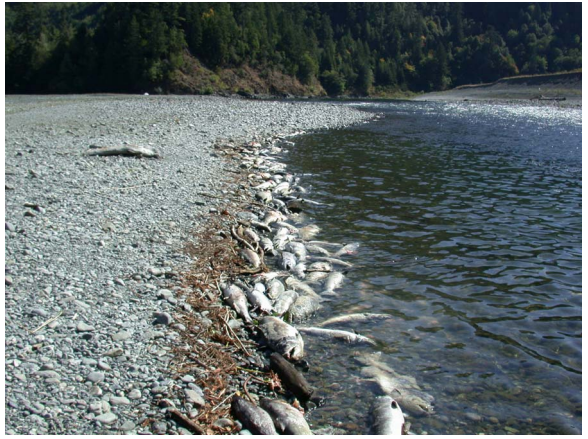The largest dam removal project in US history, and likely the world, was completed at the end of last year, with the removal of four huge dams. But with the Klamath River now running free, the river’s restoration is only just beginning. The project is featured in the new season of the BBC’s Our Changing Planet, and we spoke to presenter Liz Bonnin about traveling to the US to discover more about the scale of the demolition and how the impact of the dams has affected the river and the tribal communities that live along the Klamath.
The Klamath River has a winding, approximately 414-kilometer journey (257 miles) between Oregon and California’s north coast, where it flows into the Pacific Ocean. It once supported a healthy population of fish, including Chinook salmon, coho salmon, and steelhead trout that helped to feed the Yurok and Karuk tribes, as well as many other Indigenous tribal groups that live along the river and rely on the salmon as a mainstay of their diets.
I underestimated just how far reaching the effects of the dams had been to the wider environment… how a population of killer whales had been affected by the depletion… impacting all the way to the sea lions and seals that the orcas eat.
Liz Bonnin
However, between 1903 and 1962, hydroelectric dams were built across the length of the river, by the electric utilities company PacifiCorp. The goal was to generate enough electricity to power nearby homes but the dams had unintended consequences for both the Indigenous communities, and the fish that called the river home.
The four dams in the lower portion of the river were called Copco No. 1, completed in 1918, followed by Copco No. 2 in 1925, the J.C. Boyle Dam in 1958, and Iron Gate Dam in 1964.
However, these four dams significantly impacted the health of the river and the fish, preventing the salmon and trout species from reaching their spawning grounds. In 1997, coho salmon were listed under the federal Endangered Species Act in the Klamath. Most famous of all was the population loss suffered by the Chinook salmon.
“I admittedly completely underestimated just how far reaching the effects of the dams had been to the entire ecosystem and wider environment, all the way down to the Pacific, and how a population of killer whales had been affected by the depletion of all of the nutrients all of the fish, impacting all of the species, all the way to the sea lions and seals that the orcas eat,” Bonnin told IFLScience.
In 2002, a catastrophic die-off of the salmon occurred when high temperatures and low flow of water caused a bacterial outbreak. The estimated loss of salmon was over 34,000 fish, with some putting the loss at as many as 70,000. This spurred local tribes to continue campaign efforts from the 1990s to get the dams removed.

The fish were killed by Ichthyophthirius multifiliis, a parasite.
Photo courtesy of the Yurok Tribe – Public Domain
“It changed everything,” Brook Thompson, a Yurok and Karuk tribal member, told the BBC. “We’d always had plenty of food up until then. As a seven-year-old, the salmon were almost as big as me, and I saw thousands of their bodies piled up on the shoreline, I smelled their rotting flesh. It was apocalyptic.”
For the Klamath, once the third-largest salmon-producing river on the West Coast, this was an almighty blow. Fall chinook salmon numbers fell by 90 percent and spring chinook by 98 percent. However, after years of campaigning, in 2022, the green light was finally given to begin the removal of the four lower dams. As of October 5, 2024, these four lower dams have been successfully removed from the river.
“The tribally led effort to dismantle the dams is an expression of our sacred duty to maintain balance in the world. That is why we fought so hard for so long to tear down the dams and bring the salmon home,” said Yurok Tribal Chairman Joseph L. James in a statement.
The removal of the dams themselves is just the first step, as work carries on to restore the habitat to its pre-dam state. This involves projects like revegetation, involving hand seeding and helicopter seeding.
“That was a massive, massive project, and it was incredible to watch the teams from the Klamath renewal project working with indigenous communities and together with passion and understanding, and the will to restore the river and the wider ecosystem. They were sharing their expertise in a way that was just so joyful and magical and inspirational to watch,” said Bonnin.
As soon as October 15, 2024, just days after the completion of the dam removal project, researchers spotted multiple Chinook salmon returning to the river basin. They were even seen in Klamath tributaries in California, an area that had been blocked by the Iron Gate Dam since 1961.
“The return of our relatives to the c’iyaal’s is overwhelming for our tribe. This is what our members worked for and believed in for so many decades,” said Roberta Frost, Klamath Tribes Secretary, in a statement at the time. “I want to honor that work and thank them for their persistence in the face of what felt like an unmovable obstacle. The salmon are just like our tribal people, and they know where home is and returned as soon as they were able.”
The “Restoring Our Rivers” episode of Our Changing Planet is available now on BBC iPlayer now.
Source Link: Largest Dam Removal Project In The World Triggers Return Of Salmon After Years Of Campaigning